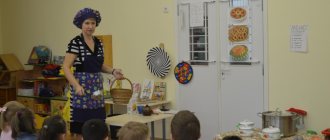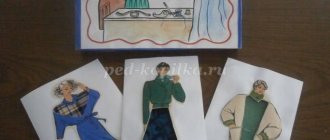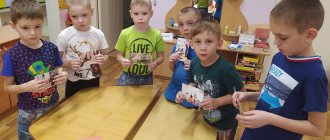Summary of the role-playing game “At a doctor’s appointment” in the middle group
Municipal budgetary preschool educational institution d/s No. 27 of the city of Yelets.
Abstract
role-playing game
"At the doctor"
in the middle group.
Prepared by the teacher:
Korobelnikova N.V.
Summary of the role-playing game “At a doctor’s appointment” in the middle group
Goal: to enrich the social and gaming experience of children in the plot of “Hospital”, to expand children’s ideas about the professions of a doctor, a nurse, their caring attitude towards sick people, to encourage independent distribution of roles, to develop gaming skills in the plot, to develop role-playing speech, to encourage the development of simple game stories with 2-3 situations (you take an appointment ticket and a card at the reception, the doctor writes out a prescription, you buy medicine at the pharmacy, you go to the treatment room for procedures).
Tasks:
Educational: learn to reveal the meaning of the activities of medical personnel, consolidate the names of medical instruments, learn to take on roles.
Developmental: Consolidate knowledge of social relations, develop game dialogue, game interaction; activate and expand your vocabulary.
Educational: instill in children a sense of gratitude to a person for his work.
Vocabulary work: Complain, phonendoscope, spatula, syringe, registry, registrar, pediatrician, procedural nurse.
Preliminary work: excursion to the medical office of the kindergarten, to the treatment room. A teacher's story about the medical profession.
Materials and equipment:: doctor's gown and cap, gowns and caps for nurses, medical instruments (thermometer, syringe, bandage, brilliant green, cotton wool, phonendoscope, screen, cards with recommendations, patient cards, appointment coupons, injection solution), vitamins .
Progress of the game
The teacher attracts the children's attention and holds a doll in his hands. (crying)
Educator: Guys, look what happened to the Alice doll. Why is she crying? Is she sick?
Children: I'm sick!
Educator: She probably got her feet wet yesterday during her walk. Spring is cold, boots are not warm enough, and they forgot to put on socks. Apparently, the doll had caught a cold in her feet, her throat and head hurt, and she had a runny nose. What to do now?
Children: We need to cure the doll.
Educator: Guys, how can you cure a doll? (children’s individual answers)
Children: Drink tea with lemon.
Educator: Well done, what else can you offer?
Children: Take your medicine. (children name their guesses about treatment methods)
Educator: Guys, but you and I don’t know what medicine should be given to the Alice doll. How to be? Who should I turn to for help?
Children: We need to call a doctor.
Educator: Where is the doctor?
Children: At the clinic.
Educator: Guys, which of you was in the clinic? Let's remember who sees the sick?
Children: Doctor, nurse.
Educator: Who will tell me when and why people come to the clinic?
Children: When they are sick. To heal
Educator: We come to the clinic and say that something hurts. What is it called?
Children: Complain.
Educator: That's right, the doctor asks “what are you complaining about?”
Guys, please tell me when we come to the clinic, do we immediately go to the doctor?
Children: No.
Educator: That's right, first we go to the registration desk. There is a nurse-receptionist sitting there who asks for your last name, first name, and home address. And only then the nurse gives you a medical card. With this medical card you go to the doctor. There is also a nurse at the reception who answers phone calls, because one of the sick people can call a doctor at home.
Are you guys ready to go to the clinic?
Children: Yes.
Educator: Guys, maybe someone’s bear or doll is sick, take them with you. And we go to the clinic.
Please note that to our left is the reception desk, to our right is the doctor’s office. I will be the doctor, Arina the nurse.
(children go to the reception desk, receive a medical card for the Alice doll and go to the doctor’s office)
Educator (
doctor
)
: Hello, what happened to you, what are you complaining about?
Children: Alice got sick, she caught a cold and is now coughing, she has a runny nose. Help us cure Alice.
Educator: Now I will examine the sick doll. (takes out a phonendoscope)
Guys, why does a doctor need a phonendoscope?
Children: Listen to the back.
Educator: That's right guys, the doctor listens to the heart, lungs, breathing. (listens to the doll)
The Alice doll is breathing heavily, so she coughs.
And this tool is called a spatula. (shows)
What does the doctor examine for them?
Children: Looks at the neck.
Educator: Well done, but before we examine the neck, we must open our mouths wide and say “Ahhhhhhh”
.
Let's say “A-a-a-a-a”
.
(the teacher examines Alice’s throat)
Children: (say)
“A-a-a-a-a”
Teacher: Guys, what is the name of this instrument? What is it for? (shows thermometer)
.
Children: This is a thermometer; they use it to measure the temperature.
Educator: Now let’s measure Alice’s temperature (the teacher shows how to apply the thermometer correctly)
And here is another tool - a syringe. What does the nurse do with this tool?
Children: They give injections.
Educator: Guys, the Alice doll is very sick, her neck is red, her temperature is high, and she has a cough. The nurse will now write you a prescription for medicine, give you an injection, and the Alice doll will be healthy.
Educator: Well done guys, you are very caring and attentive.
Let's continue our game, but for this we need to distribute the roles between you. How many of you want to be a doctor? The nurse who sits at the reception desk? Medical registrar? The most responsible of you will be the doctor. We have a real clinic with you.
Choice of roles.
The children take their places. One by one, they approach the register and give their last name, first name, and address. The child medical registrar issues cards. (the same geometric shapes are drawn on the cards as on the badges of child patients). Then the children take turns approaching the doctor.
Child doctor: Hello, come in, sit down. What's your last name? What are you complaining about, what hurts?
Sick child: My throat hurts.
Doctor: Let me examine you. Open your mouth. Say "ah-ah"
. I'll examine you with a spatula. Don't be alarmed. Yes, the neck is red. Go to the nurse. She will put a thermometer on you and give you some medicine.
One by one, the children approach either the doctor or the nurse.
The game continues until the last child patient.
Summing up the game:
1. Did you like the game?
2. Did the children like the doctor? Nurse? Medical registrar? (yes or no, and why)
.
3. Did the child like being in the role of a doctor, nurse, medical receptionist and patient?
Educator: Guys, you came to the clinic sad and sick. And now the doctor has treated you, and you have become healthy, mischievous, cheerful, as you were before your illness.
Children are given sweet gifts.
Literature:
1. N. A. Vinogradova Role-playing games for preschoolers: a practical guide / N. A. Vinogradova, N. V. Pozdnyakova. – M.: Iris-press, 2008. – 128 p.
Summary of a role-playing game in the middle group “Polyclinic”
Summary of a plot-role-playing game in the middle group.
Topic : " Polyclinic"
Target:
enriching social and gaming experience between students, developing gaming skills.
Tasks:
Teach children to act according to the role they have assumed, to develop the plot.
Continue working with children to develop and enrich the plots of games, using indirect methods of guidance, leading children to independently create game ideas.
Encourage children to creatively play the role of a doctor and parents of a sick doll.
Improve children's ability to unite in play.
Learn to select items and attributes for the game.
Foster friendly relationships between children.
Technology used
: Information and communication.
Health-saving.
Preliminary work.
Familiarize yourself with the tools and appearance of the doctor. Stories about the professions of medical workers.
Activate the words in speech: doctor, nurse, pharmacist and registrar, prescription.
Conversations based on children’s personal experiences about doctors, clinics and hospitals.
Reading fiction: K. Chukovsky “Aibolit”, Alexandrova “My Bear”, A. Krylov “The rooster got sick with tonsillitis”.
An excursion to a medical office in a kindergarten, a visit by children to a pediatrician at the clinic.
Didactic game: “Which doctor should the bear see?”
Didactic game: “Professions”.
Materials:
Play corner “Hospital”, Masha doll, attributes for the roles of mom and dad, medical instruments, a white coat for a doctor, nurse and pharmacist, attributes for a clinic and pharmacy, toy phones, toys.
Lesson structure.
1. Surprise moment (the Masha doll arrives).
2. Distribution of roles in the game: doctor, nurse, mother, father, pharmacist, registrar.
3. Game management.
4. Summary of the lesson.
Progress of the game:
Children greet guests.
1. Game situation: (children sitting on the carpet)
There's a knock on the door. They bring a doll Masha, who wants to go home to mom and dad. She is naughty because her throat hurts.
- Children, the doll Masha is sick. Let's play the game "Polyclinic". We will treat the doll.
2.-Today Eva will be a mother, Lesha will be a father, Ilyas will be a doctor, Olya will be a nurse, Olesya will be a receptionist at the reception, and Vera will be a pharmacist at a pharmacy. The teacher clarifies knowledge about each role.
(distribution of roles using a “magic box”).
— We have distributed the roles and everyone goes to their workplace.
3. Dad, mom and little daughter Mashenka live in this house. Today is a weekday evening. Parents took sick Masha from kindergarten and went to the clinic to see a doctor.





